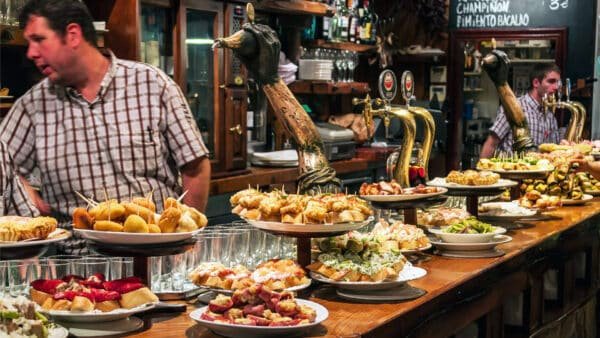In Spain, the gap between “budget traveler” and “living well” is refreshingly narrow. While you might not get a velvet robe and a crown for $75 a day, you can get a glass of Rioja, a long lunch in the sun, and a private room in a charming town. With a bit of planning and a soft spot for the simple life, a budget trip to Spain can feel like a top-tier vacation. Here’s how to make every euro count:
Skip the Hotspots, Stay Somewhere Real

First things first: you’re going to have to skip the usual tourist hotspots. Barcelona, Madrid, Mallorca, and Ibiza are all out. Instead, you’ll find yourself in a more affordable corner of Spain, that will be more authentic anyway. These are the kinds of places where life moves slower, prices are lower, and the charm isn’t artificially curated for tourism.
By booking a room in a locally-run guesthouse or casa rural in a smaller town, you can often find private rooms for €40 to €60 a night, sometimes with breakfast included. Towns like Vejer de la Frontera (in Andalusia), Palafrugell (in Catalonia), or the small villages near Albacete (in Castilla-La Mancha) offer plenty of character without the crowds or the price tag. You’ll likely need a car to get to them, but once you do, it’s quiet, walkable, and you’ll feel like you’re in your own little kingdom, all without breaking the bank.
Go When Everyone Else Stays Home

Busy season in Spain means higher prices, more crowds, and longer lines. Since those are all things you’re trying to avoid anyway, why not plan your trip for the shoulder season? In late spring (end of April to early June) or early autumn (late September to end of October), the weather is still gorgeous and the tourists are fewer. You’ll find better deals on flights and accommodations, fewer people in the background of your photos, and more euros left in your wallet once your trip is over.
Eat Like a King, Pay Like a Local

You don’t need a five-star budget to eat well in Spain, you just need to know when and where to eat. Look for places offering a menú del día at lunchtime: you’ll get multiple courses, bread, a glass of wine, and a small dessert typically for about €10 to €15. It’s what locals do, and it’s hands-down the best value meal you’ll have all day.
At night, skip the formal dinner and head to a neighborhood bar. Particularly in the south of Spain, tapas often come free with a drink. Order a caña (a small beer) and along with it you’ll be handed a small plate of something delicious — a few beers later and you’ll be full without even ordering a full entree. It’s casual, cheap, and often more fun than going to that exclusive restaurant that you needed a reservation for.
Beach Day on a Budget

You don’t need a daybed rental, overpriced cocktails, or some “exclusive” beach club with velvet ropes to enjoy Spain’s magnificent coastline. Instead, hit up a local supermarket on the way, bring your own sandwiches and drinks (yes, that’s allowed), and post up for the day. No entry fees, no VIP wristbands, no minimum spend required. Spain’s beaches are public, beautiful, and yours to rule for the day the way the locals do: for free.
Travel Smarter, Not Faster

Renting an expensive car for your whole trip or pricey high-speed train tickets are unnecessary when it comes to hopping around the country. Spain has a solid network of long-distance buses (such as Alsa) that are clean, comfortable, and cheap, sometimes as little as €5 to €10 if you book early. For shorter routes, regional trains and rideshares like BlaBlaCar are surprisingly easy and cost-effective.
You can also look into discounted rail passes, like Renfe’s Spain Pass, which gives you a set number of train journeys for a flat rate. It’s not always significantly cheaper than individual tickets, but it can be a good deal if you’re trying to cover a lot of ground. Either way, a little planning ahead will help your transport budget go even further.
Don’t Try to Do It All

Keep in mind that if you try to squeeze seeing eight cities into ten days, not only are you going to spend a fortune, but you’re going to miss out on the best part of the Spanish lifestyle: slowing down. Instead of packing your itinerary to the brim, keep a few of your days completely unplanned and just go with the flow, order a second coffee at that cute sidewalk café, linger over a long lunch when the conversation is good, or spend an afternoon getting lost in a neighborhood outside of the city center with no set plan. After all, vacations are meant to be relaxing, and the best part? Slowing down costs nothing.
No Throne Needed

You don’t need a palace, a private driver, or a platinum credit card to live well in Spain. With a little intention and a willingness to take things slow, $75 a day can get you the things that actually matter: good food, a nice place to sleep, great views, and a better vacation than some people might have on triple the budget. You just might find that living like royalty has less to do with money, and more to do with spending your time wisely.
